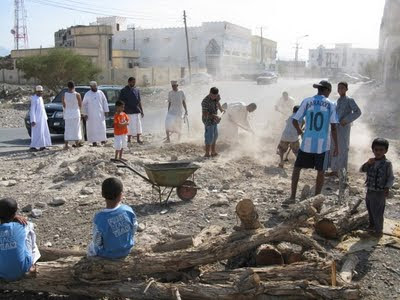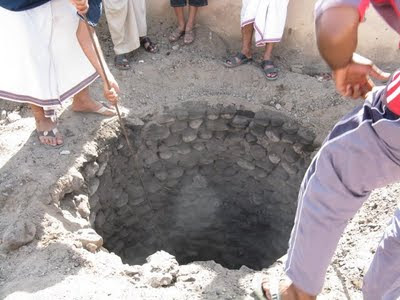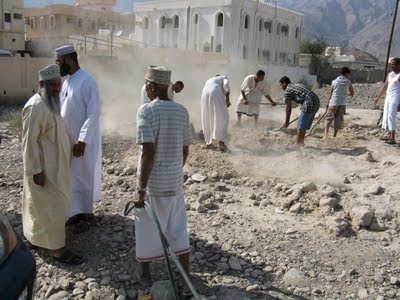
There are two Eids in Oman---the one that is coming up:
Eid ul-Fitr, the one at the end of Ramadaan, so I thought I'd write a post about Eid ul-Fitr just to explain what it is, and what is done for it in Oman, in case anybody staying in Oman was curious or chance is invited to participate in the holiday. Both Eids are Islamic Holidays, and Eid ul-Fitr is a 3 day holiday that always begins with the end of Ramadaan. Eid means "holiday/festivity" and "ul-Fitr" means "original/best nature". So it is a holiday Muslims celebrate, as they are supposed to be morally, spiritually, intellectually, and physically improved since fasting the month of Ramadaan.

In Oman for Eid, we keep the Islamic tradition of waking well before sunrise and puting on new, or our best clothes. As we do so we are supposed to put aside any old resentments, and be thankful to God/Allah. In our village usually 3 days of new clothes are purchased before the start of Ramadaan to be worn for Eid ul-Fitr, and the clothes are usually of a traditional Gulf nature, either Omani, or GCC in style, but in Muscat my friends wore anything from the same to Western clothing from Monsoon, ect to Morrocan traditional dress. We women usually put on our favourite jewelry, as well as painting our hands and feet with henna. The men wear their dishdashes along with their khanjar daggers and carry the assa sticks. Many will perfume themselves, and will take a small meal, as in Islam, fasting is forbidden for the day of Eid. In our village the traditional meal we eat on this day is called "Harees" made from rice and chicken. This is also the time, that if anyone has not paid the charitable tax that they owe for the poor on any of their property that falls under the jurisdiction of savings, wealth, or gold (called "zakat"), they must pay it.

Before sunrise it is part of Islamic tradition for both men and women to go out for prayer before the sun rises, and pray it together. Even those who are unable to pray come out for the prayer. In our village while all the people come out for the prayer, only the men pray it, which is part of Omani culture, not Islam. I will pray it. I am Muslim before I am Omani. After the prayer a lecture called a khutbah is said aloud and every Muslim is supposed to stay to listen. It is a tradition to take one route to the prayer, and a different one away from it, saying a prayer as one goes to and from the congregational prayer ground.

Eid is a time that singing is permitted, and children visit and play. Usually we women sit inside and visit with eachother in our nicest or newest clothes, while the men go outside to cut an animal, in our village, usually a cow, goat, or sheep. This part is an Islamic practice, but the foods made from the meat is an Omani tradition for Eid unique to the region.

After the meat is cut, it is divided into sections, one section for the men to keep, for the "shua", and one section for the women for the "mishakeek", some of the men season their section of meat, wrap it in banana leaves and then bags made from date palm (or aluminum foil) and carry it to the place for making the "shua".



After the shua meat is ready for cooking, the men go to the place reserved for cooking the shua, and burn wood in the hole for the shua, until hot coals are left, and they lightly cover this with sand, but not enough to put the coals out.



The bags of the seasoned shua meat are lowered into the pit, and then buried underground where they will be left to cook overnight or for one day.

While the men are doing this, usualy we women change into less formal clothes, and the cut the meat we have been given, and prepare it for lunch.


We make it into kebabs called "mishcock" ["mishakeek" plural], and season them. Men that are not in charge of preparing the shua, then cook the mishakeek.


For lunch on the first day of Eid we usually enjoy the mishakeek. mmmmm yum (as I write this I am fasting so Eid seems like such a nice thing to envision lol).

During the Eid it is a time that alot of us share food, and give optional extra charity (different than the charity tax due by the end of Ramadaan).

In our village, money is given to those in need, women, and children.

Children collect usually a huge score of rials and baisa notes in Oman. They enjoy walking to the store to purchase toys and candies in the early evening of every Eid day in our village.


On the second Eid day we usually eat more mishakeek or the shua meat with rice for the lunch and mass visiting begins.

Every house we visit, usally fruit, coffee, and sweets are offered. Whenever I visit in Muscat I am overwhelmed with nuts, chocolates, and of course Patchi. I always make sure to wear shoes that are easy to take on and off for this day! The traditional gretting is "Eid Mubarak" or "Eid Sa'eed",: 1. Eid Congratulations, 2. Happy Eid. Finally, for the 3rd day of Eid, in our village there are traditional dances and songs preformed, and some traditional games for the girls. That is pretty much Eid ul-Fitr as I know it in my regions of Oman;)

 There are two Eids in Oman---the one that is coming up: Eid ul-Fitr, the one at the end of Ramadaan, so I thought I'd write a post about Eid ul-Fitr just to explain what it is, and what is done for it in Oman, in case anybody staying in Oman was curious or chance is invited to participate in the holiday. Both Eids are Islamic Holidays, and Eid ul-Fitr is a 3 day holiday that always begins with the end of Ramadaan. Eid means "holiday/festivity" and "ul-Fitr" means "original/best nature". So it is a holiday Muslims celebrate, as they are supposed to be morally, spiritually, intellectually, and physically improved since fasting the month of Ramadaan.
There are two Eids in Oman---the one that is coming up: Eid ul-Fitr, the one at the end of Ramadaan, so I thought I'd write a post about Eid ul-Fitr just to explain what it is, and what is done for it in Oman, in case anybody staying in Oman was curious or chance is invited to participate in the holiday. Both Eids are Islamic Holidays, and Eid ul-Fitr is a 3 day holiday that always begins with the end of Ramadaan. Eid means "holiday/festivity" and "ul-Fitr" means "original/best nature". So it is a holiday Muslims celebrate, as they are supposed to be morally, spiritually, intellectually, and physically improved since fasting the month of Ramadaan. In Oman for Eid, we keep the Islamic tradition of waking well before sunrise and puting on new, or our best clothes. As we do so we are supposed to put aside any old resentments, and be thankful to God/Allah. In our village usually 3 days of new clothes are purchased before the start of Ramadaan to be worn for Eid ul-Fitr, and the clothes are usually of a traditional Gulf nature, either Omani, or GCC in style, but in Muscat my friends wore anything from the same to Western clothing from Monsoon, ect to Morrocan traditional dress. We women usually put on our favourite jewelry, as well as painting our hands and feet with henna. The men wear their dishdashes along with their khanjar daggers and carry the assa sticks. Many will perfume themselves, and will take a small meal, as in Islam, fasting is forbidden for the day of Eid. In our village the traditional meal we eat on this day is called "Harees" made from rice and chicken. This is also the time, that if anyone has not paid the charitable tax that they owe for the poor on any of their property that falls under the jurisdiction of savings, wealth, or gold (called "zakat"), they must pay it.
In Oman for Eid, we keep the Islamic tradition of waking well before sunrise and puting on new, or our best clothes. As we do so we are supposed to put aside any old resentments, and be thankful to God/Allah. In our village usually 3 days of new clothes are purchased before the start of Ramadaan to be worn for Eid ul-Fitr, and the clothes are usually of a traditional Gulf nature, either Omani, or GCC in style, but in Muscat my friends wore anything from the same to Western clothing from Monsoon, ect to Morrocan traditional dress. We women usually put on our favourite jewelry, as well as painting our hands and feet with henna. The men wear their dishdashes along with their khanjar daggers and carry the assa sticks. Many will perfume themselves, and will take a small meal, as in Islam, fasting is forbidden for the day of Eid. In our village the traditional meal we eat on this day is called "Harees" made from rice and chicken. This is also the time, that if anyone has not paid the charitable tax that they owe for the poor on any of their property that falls under the jurisdiction of savings, wealth, or gold (called "zakat"), they must pay it.  Before sunrise it is part of Islamic tradition for both men and women to go out for prayer before the sun rises, and pray it together. Even those who are unable to pray come out for the prayer. In our village while all the people come out for the prayer, only the men pray it, which is part of Omani culture, not Islam. I will pray it. I am Muslim before I am Omani. After the prayer a lecture called a khutbah is said aloud and every Muslim is supposed to stay to listen. It is a tradition to take one route to the prayer, and a different one away from it, saying a prayer as one goes to and from the congregational prayer ground.
Before sunrise it is part of Islamic tradition for both men and women to go out for prayer before the sun rises, and pray it together. Even those who are unable to pray come out for the prayer. In our village while all the people come out for the prayer, only the men pray it, which is part of Omani culture, not Islam. I will pray it. I am Muslim before I am Omani. After the prayer a lecture called a khutbah is said aloud and every Muslim is supposed to stay to listen. It is a tradition to take one route to the prayer, and a different one away from it, saying a prayer as one goes to and from the congregational prayer ground. Eid is a time that singing is permitted, and children visit and play. Usually we women sit inside and visit with eachother in our nicest or newest clothes, while the men go outside to cut an animal, in our village, usually a cow, goat, or sheep. This part is an Islamic practice, but the foods made from the meat is an Omani tradition for Eid unique to the region.
Eid is a time that singing is permitted, and children visit and play. Usually we women sit inside and visit with eachother in our nicest or newest clothes, while the men go outside to cut an animal, in our village, usually a cow, goat, or sheep. This part is an Islamic practice, but the foods made from the meat is an Omani tradition for Eid unique to the region. After the meat is cut, it is divided into sections, one section for the men to keep, for the "shua", and one section for the women for the "mishakeek", some of the men season their section of meat, wrap it in banana leaves and then bags made from date palm (or aluminum foil) and carry it to the place for making the "shua".
After the meat is cut, it is divided into sections, one section for the men to keep, for the "shua", and one section for the women for the "mishakeek", some of the men season their section of meat, wrap it in banana leaves and then bags made from date palm (or aluminum foil) and carry it to the place for making the "shua".

 After the shua meat is ready for cooking, the men go to the place reserved for cooking the shua, and burn wood in the hole for the shua, until hot coals are left, and they lightly cover this with sand, but not enough to put the coals out.
After the shua meat is ready for cooking, the men go to the place reserved for cooking the shua, and burn wood in the hole for the shua, until hot coals are left, and they lightly cover this with sand, but not enough to put the coals out.

 The bags of the seasoned shua meat are lowered into the pit, and then buried underground where they will be left to cook overnight or for one day.
The bags of the seasoned shua meat are lowered into the pit, and then buried underground where they will be left to cook overnight or for one day. While the men are doing this, usualy we women change into less formal clothes, and the cut the meat we have been given, and prepare it for lunch.
While the men are doing this, usualy we women change into less formal clothes, and the cut the meat we have been given, and prepare it for lunch.
 We make it into kebabs called "mishcock" ["mishakeek" plural], and season them. Men that are not in charge of preparing the shua, then cook the mishakeek.
We make it into kebabs called "mishcock" ["mishakeek" plural], and season them. Men that are not in charge of preparing the shua, then cook the mishakeek.
 For lunch on the first day of Eid we usually enjoy the mishakeek. mmmmm yum (as I write this I am fasting so Eid seems like such a nice thing to envision lol).
For lunch on the first day of Eid we usually enjoy the mishakeek. mmmmm yum (as I write this I am fasting so Eid seems like such a nice thing to envision lol). During the Eid it is a time that alot of us share food, and give optional extra charity (different than the charity tax due by the end of Ramadaan).
During the Eid it is a time that alot of us share food, and give optional extra charity (different than the charity tax due by the end of Ramadaan). In our village, money is given to those in need, women, and children.
In our village, money is given to those in need, women, and children.  Children collect usually a huge score of rials and baisa notes in Oman. They enjoy walking to the store to purchase toys and candies in the early evening of every Eid day in our village.
Children collect usually a huge score of rials and baisa notes in Oman. They enjoy walking to the store to purchase toys and candies in the early evening of every Eid day in our village.
 On the second Eid day we usually eat more mishakeek or the shua meat with rice for the lunch and mass visiting begins.
On the second Eid day we usually eat more mishakeek or the shua meat with rice for the lunch and mass visiting begins. Every house we visit, usally fruit, coffee, and sweets are offered. Whenever I visit in Muscat I am overwhelmed with nuts, chocolates, and of course Patchi. I always make sure to wear shoes that are easy to take on and off for this day! The traditional gretting is "Eid Mubarak" or "Eid Sa'eed",: 1. Eid Congratulations, 2. Happy Eid. Finally, for the 3rd day of Eid, in our village there are traditional dances and songs preformed, and some traditional games for the girls. That is pretty much Eid ul-Fitr as I know it in my regions of Oman;)
Every house we visit, usally fruit, coffee, and sweets are offered. Whenever I visit in Muscat I am overwhelmed with nuts, chocolates, and of course Patchi. I always make sure to wear shoes that are easy to take on and off for this day! The traditional gretting is "Eid Mubarak" or "Eid Sa'eed",: 1. Eid Congratulations, 2. Happy Eid. Finally, for the 3rd day of Eid, in our village there are traditional dances and songs preformed, and some traditional games for the girls. That is pretty much Eid ul-Fitr as I know it in my regions of Oman;)











No comments:
Post a Comment